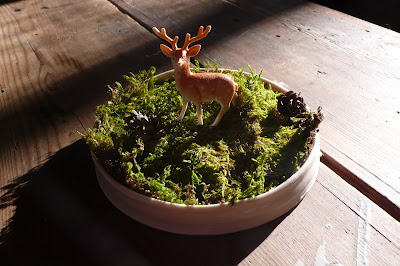The structure of the barn looks rather stark to me at some points in time. I appreciate the architecture of my "squat tower" in the landscape, but it has always seemed plopped; as if it was dropped from the sky.
I have been going back in forth, in my head whether to plant gardens in front or not since last summer when we bought the house. One voice says to me,"the structure is beautiful on it's own, minimal is better". While the other voice says, "You're a garden designer, every structure needs a foundation planting, plus you can never have too many gardens".
So guess which voice won? Of course gardens.
I also thought this would be a good opportunity to share with you, the foundations and steps of creating a garden.
When I decided to go ahead and design the new pottery gardens, I went back to my initial design I completed over the past winter.
I would create two curved stone walls flanking the entrance of the barn and they would arch around the sides to the back.
The planting would all be shade tolerant, as the only direct sunlight that comes through the trees is for only an hour during mid-morning.

Then when I was about to execute this plan, another idea came to me.
Maybe a better option would be to have two small beds with perfectly square footprints, with lower rock walls as edging.
After sitting out in front of the pottery for an hour contemplating these designs, I consulted with Stephen. He liked both propositions, but favored the "square gardens". He mentioned the fact that around the grounds of the M.H. Merchant House, we had already had several perennial borders with sweeping curves. The square lines of the new pottery gardens would fit the architecture and create a different feeling down at the pottery.
It was settled, square it is!
I set down to the barn with the wheel barrow, two shovels, rake, and a tape measure. I measured out from the corners to 6ft. and then placed a small marker stone. With a flat spade I edged a complete square, which would be the footprint of the garden.

Then with the same spade , I scraped off a layer of roots, moss, and weeds, to a depth of 2 inches.
Now the beds were starting to take shape.

The next debate I had was, whether or not to build a stone wall to retain the new beds. The prospect of working with stone would normally be great, but the past week I just completed a new stone patio off our kitchen and I was still a little sore.
I new the walls would look great; they would give a real sharp shape to the gardens as well as adding another texture. So I just bit my lip and went into the woods and began gathering stones. Several hours later and I thought there was enough stone to start.

I start with the largest stones first with the straightest edge always facing out. I place them in a single layer and work the perimeter. Then come additional stones and so on, stone on stone, layer after layer until the desired height is complete.

When the walls were complete, I set out the next day to amend and till the new beds. I dumped 8 bags of topsoil and 1 large bale of peat moss in each bed.
Then comes the fun part, rototilling! I powered the little baby up and got to tilling, until all the different soils were incorporated.


I quickly dug up some perennials from my other shade garden and added some rocks that I found the other day in the woodland that would hold water, both for the birds and to please the eye.

The next stage was to plan in my head how the gardens should look. I sat down in front of the pottery and the new beds and began to think of all the different plants to choose from.
I new I was dealing with a deep shade type of environment, but there are so many great botanical choices out there.
After the concept was finished in my thoughts, I jotted down on a note card my "recipe list" of plant material.

The list is basically a wish list, for when I often go to garden centers to execute my plans, I always deviate and select different plants for other reasons.
The bones of the concept though tend to stay true to my initial design.
With note in hand I headed to my favorite local nursery and dropped a small fortune. It was more than I wanted to spend, but I wanted a full look, and most of the plants were on sale.
I loaded my little Subaru hatchback up with plants until some of them were hanging out of the windows.
I chose to go with a quite color pallet of burgundy, plums, hints of white and different shades of green.

The plants were selected for both their foliage color and there bloom time; so there will be something showy from spring until late in the fall.
I planted two red twig dogwoods, a few canna, and lots of hucheras, ferns, and other shade loving perennials.


With the new gardens completed they really helped the pottery become more of a destination from the road.
It just seems a bit more inviting and I think has a more comfortable feel.

In fact that day we had several visitors and even more sales.
I guess a little curb appeal can go a long way.






















































